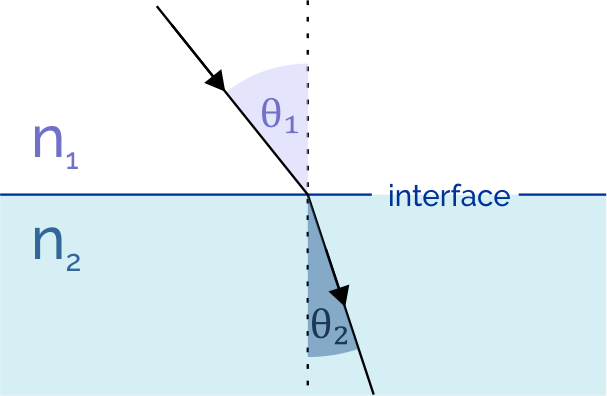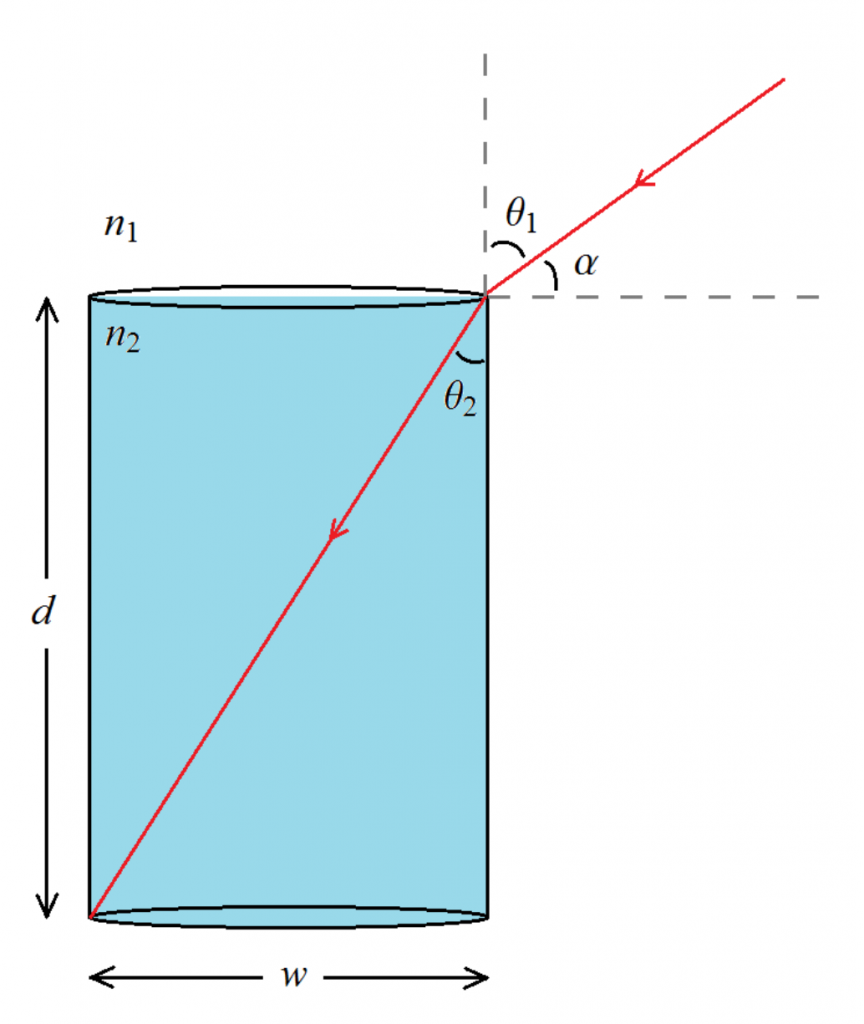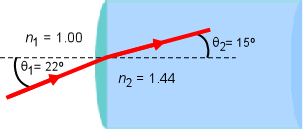Snell’s Law also called as Law of Refraction, is usually stated as, \(n_1 \sin \theta_1 = n_2 \sin \theta_2\), where \(\theta_1\) is angle of incidence and \(\theta_2\) is angle of refraction and n1, n2 are refractive indices of the two media.
Index
History
Snell’s Law describing refraction was first recorded by Ptolemy in 140 A.D. It was first described by a relationship by Snellius in 1621. Willebrord Snellius (1580–1626) was a Dutch astronomer and mathematician.
Snell’s Law was explained for the first time in 1650 by Fermat’s principle of least time. This law has counterparts in other physical contexts, where electromagnetic fields exhibit similar properties.
Snell’s Law Explained
In vacuum, light travels approximately at 2.99 x 108 m/s. Which is defined as c. When light propagates through various materials it will travel at a velocity v, which is less than the speed of light.
We calculate the index of refraction(n) of the material that light is passing through by n = c/v. Refractive indices are always greater than one.
The degree of refraction or bending depends on the relative refractive indices of the two mediums according to a relationship called Snell’s Law.
Snell’s law states the following:
\(n_1 \sin \theta_1 = n_2 s\in \theta_2\)
Where n1 indicates the index of refraction of the first medium
n2 indicates the index of refraction of the second medium.
θ1 indicates the angle of the initial beam of light with respect to the normal on the surface of the second medium
θ2 indicates the angle of the light beam entering into the second medium.

When light rays from a low index medium enter a higher index medium, the rays will bend toward the normal line on the incident surface. The opposite will occur if the rays of light go from a medium of a higher index to a lower index.
Total Internal Reflection and Critical Angle
When a ray of light travels from denser to rarer medium, it bends away from the normal and as the angle of incidence in denser medium increases, the angle of refraction in rarer medium also increases and at a certain angle, angle of refraction becomes 90o, this angle of incidence is called Critical Angle (θc).
From Snell’s law,
Sin(θ1)/ Sin(θ2) = n2/n1
Sin(θc)/ Sin(90) = n2/n1
Critical angle (θc) = arcsin(n2/n1)
If the angle of incidence of the light ray exceeds the critical angle then the light ray comes back into the same medium after reflection at the interface. This is called Total Internal Reflection (TIR).

Examples on Snell’s Law
Question 1. If a ray is passing from air into a medium at an angle 34° and the refractive index of the medium is 1.2, calculate the angle of incidence of the ray.
Solution. Given that n2 = 1.2; θ2 = 34
We know n1 = 1
From Snell’s law, we know that
Sin(θ1)/ Sin(θ2) = n2/n1
Sin(θ1)/ Sin(34°) = 1.2/1
Sin(θ1)= Sin(34°) × 1.2 = 0.671
θ1 = sin-1 (0.67)
θ1 = 42.15°
Angle of Incidence = 42.15°.
Question 2. A cup of water is placed on a table outside in the sunlight and is filled to the top. The sun happens to be 45o above the horizon and you notice the bottom of the cup has just become completely shaded. The cup has a depth of 15cm and you wanted to calculate the width of the bottom of the cup. Find the width in cm.
Solution.

Let α be the angle w.r.t. the horizon that the sun is at i.e 45 and d is the depth of the water.
Since the light passes from air into water n2= 1.33; n1 = 1.
θ1 + α = 90°
θ1 = 90° – 45° = 45°
From Snell’s law, we know that
Sin(θ1)/ Sin(θ2) = n2/n1
Sin(45°)/ Sin(θ2) = 1.33/1
Sin(θ2)= Sin(45°)/1.33 = 0.53
θ2= Sin-1(0.53)= 32.1°
d and w forms a right angle triangle with an angle of θ2. Using the tangent
tan(θ2)= w/d
w = d tan(θ2) = 15 tan(32.1°)
w = 9.4cm
Width of the cup = 9.4cm
Question 3. A light travelling from air into an optical fiber which has an index of refraction of 1.44.
- In which direction does the light bend?
- If the angle of incidence on the end of the fiber is 22o, what is the angle of refraction inside the fiber?
- Sketch the path of light as it changes media.
Solution.
1. Since the light ray is traveling from a rarer region (air) to a denser region (fiber), it will bend toward the normal.
2. Given that θ1 = 22o ; n2= 1.44; n1= 1
From Snell’s law, we know that
Sin(θ1)/ Sin(θ2) = n2/n1
Sin(22o)/ Sin(θ2) = 1.44/1
Sin(θ2)= Sin(22°)/1.44 = 0.26
θ2= Sin-1(0.26)= 15°
The angle of refraction inside the fibre is 15°
3. The path of the light is shown in the figure below.

FAQs
We cannot apply Snell’s law for calculating the refraction angle of a finite beam.
i is angle of incidence and r is angle of refraction.
This is the other way of representing θ1and θ2.
Yes, sound waves obey Snell’s law.
